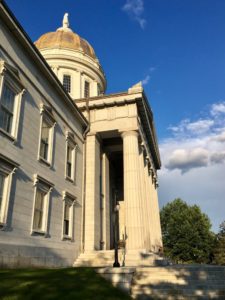New Climate Action Commission Creates Potential Venue for Real Progress
By Johanna Miller
In June, the Trump administration abdicated their responsibility to act on climate change when they withdrew the United States from the Paris Agreement. That left the U.S. in isolation from every other nation in the world who has committed to dramatically reducing greenhouse gas emissions, with the exception of war-torn Syria and Nicaragua, a clean-energy innovating nation which doesn’t think the agreement goes far enough.
It’s a stark and sobering picture. It puts an increasingly costly burden on young people and future generations. It also leaves the greatest job-creating, economic development opportunity this world has ever seen in the hands of global innovators who understand that the future – and financial prosperity for all – is in the clean energy sector.
The reality is that action on climate now lies squarely with the states.
Thankfully, on the heels of President Trump’s shortsighted withdrawal from the Paris Agreement, there have been a several state-based efforts taking root.
In Vermont, Burlington Mayor Miro Weinberger brought together mayors from across the state, the Governor, the Lake Champlain Chamber of Commerce, the Vermont League of Cities and Towns and many others partners to cement Vermont’s commitment to meeting not just the Paris Agreement, but our own statutory greenhouse gas reduction and Comprehensive Energy Plan goals. That effort – the Vermont Climate Pledge Coalition – intends to motivate as many Vermonters as possible to do their part in reducing the state’s greenhouse gas emissions.
The Climate Pledge Coalition effort will also dovetail well with another new initiative: the Vermont Climate Action Commission (VCAC). In July, Governor Phil Scott, through Executive Order, established a 21-member commission and charged this diverse body with developing strategies the state can implement to meet Vermont’s greenhouse gas emissions reduction, renewable energy, and economic development goals. He gave the Commission both a short- and longer-term charge. Short term, he asked for three specific strategies to consider by December 31, 2017 with the hope of making meaningful progress in the 2018 legislative session. Longer term, he charged the Commission with drafting and making recommendations in an action plan aimed at achieving the state’s clean energy, climate, and economic development goals.
On August 15, 2017, the VCAC held its first meeting. VCAC co-chair, Agency of Natural Resources Deputy Secretary Peter Walke, made clear to the new Commissioners the importance of their work. Addressing the pressing challenge of climate change can, and should be, one of the greatest economic development opportunities Vermont has ever seen. In reducing our green house gas pollution, we can invest in the future of Vermont and, if done well, provide a pathway of opportunity for all Vermonters.
While the creation of this Commission is a hopeful first step, it must result in real action to cut emissions. Despite everything Vermont has done in the clean energy arena – which has helped keep our electric rates the second lowest in New England and spur our now fastest-growing job sector – we are still way off track in meeting our emissions-reduction goals.
At the VCAC’s first meeting, Agency of Natural Resources Air Quality and Climate Division Planning Section Chief, Jeff Merrill, overviewed the state’s latest carbon inventory report. The takeaway: Vermont’s CO2 emissions are up four percent above 1990 levels (instead of down 25 percent by 2012, per our state’s statutory goal). We’re not moving forward. We are moving backward.
To make needed progress and to actually achieve dramatic greenhouse gas emissions reductions, substantive strategies, policies, and approaches will be required. That means all decisions must be premised upon the scientific consensus of human-induced climate change. It means identifying and supporting solutions commensurate with the challenge we face, including pricing carbon pollution. It means thinking and acting comprehensively across all sectors – heating, transportation and electricity.
It also means getting down to brass tacks; identifying a diverse portfolio of policy and programmatic solutions, putting real political muscle into advancing those solutions and ensuring all Vermonters can and do participate in this needed energy transformation.
Making progress won’t be easy – but it is imperative to ensure the economic opportunity for all Vermonters today and in the future. Here’s how you can help.
-
Show up at one of the public scoping sessions this fall to inform the Vermont Climate Action Commission’s work or attend one of its meetings. Find out more about the Commission and find a public meeting near you at: http://anr.vermont.gov/vermont-climate-action-commission.
-
Let the Governor know where you stand. Call or email him and let him know you hope he will support the substantive solutions required to make real progress for Vermont, including policies like carbon pricing. Contact Governor Scott at: http://governor.vermont.gov/contact.
-
Show up and speak up at some important upcoming events on climate action (see the accompanying sidebar).
-
Meet with and ask your legislators and local officials to lead on the solutions necessary to turn this challenge into opportunity.
Johanna Miller is the Energy and Climate Program Director at the Vermont Natural Resources Council, as well as one of the members of the Vermont Climate Action Commission. Reach her at jmiller@vnrc.org or www.vnrc.org.









Leave a Reply